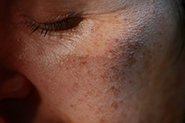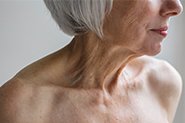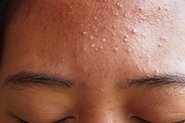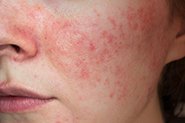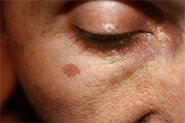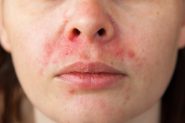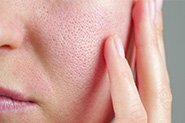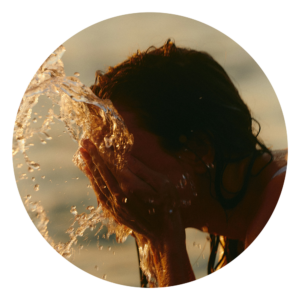
Why Sun Protection in Australia is Non-Negotiable
When it comes to skin health, understanding radiation from the sun, and its impact, is crucial for anyone treating melasma, rosacea, acne, sun damage, and general aging concerns. While UV radiation is widely recognised as harmful, visible light also plays a significant role in causing skin aging, rosacea and pigmentation. In this guide, we’ll delve into the science behind these radiation sources, and offer practical advice on how to protect your skin and get the most from your treatment.
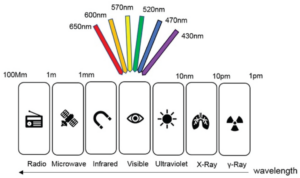
Understanding UV Radiation: The Basics
UVR is a part of the electromagnetic spectrum emitted by the sun. It comprises 3 wavelengths: UVA, UVB, and UVC: UVC (100-290nm): Completely blocked by the Earth’s atmosphere, so UVC does not affect our skin directly. UVB rays make up about 5% of the UV radiation that reaches the Earth’s surface. They cause sunburn (‘B’ for Burn) and skin cancers. UVB is mostly absorbed by the outermost skin layer (the stratum corneum), with only a small percentage reaching the deeper epidermis and dermal layers.
UVA: The Sneaky Skin Ager
UVA rays make up the remaining 95% of the UV radiation that reaches us. These rays penetrate much deeper than UVB, reaching into the dermis to break down our skin’s collagen and elastin, which form the supporting network for skin. Over time, this leads to premature skin aging, called ‘photoaging’ (‘A’ for Aging). Unlike UVB, UVA rays are sneaky – they do not cause immediate visible damage like sunburn, or generate heat, so we are often unaware of the damage they cause until it’s too late. They also remain at relatively consistent levels throughout the year, and penetrate through glass, making them widely present indoors (and in the car!). Your UVA dose accumulates in your skin both throughout the day whilst you are going about your daily activities, and over a lifetime. This is why 80-90% of the signs of skin ageing are simply from daily exposure, not from heading to the beach every now and then. UVA can be further divided into shortwave UVA (UVA-2, 320–340 nm) and longwave UVA (UVA-1, 340–400 nm).
What’s so Special about UVA-1? UVA-1 makes up the majority of UVA radiation – and therefore makes the biggest contribution to the damaging effects of UVR on the skin. So your sunscreen needs to specifically focus on UVA-1, not just UVA in general.
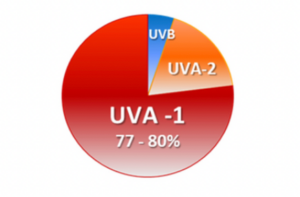
But it’s not just about UV radiation…
The electromagnetic spectrum encompasses all forms of electromagnetic energy on earth – visible and invisible. When it comes to skin protection, we need to focus on both ultraviolet (UV) AND visible radiation from the sun.
Visible Light (VL): The Overlooked Skin Aggressor
Visible light (400-700nm( makes up 50% of the total radiation reaching the earth’s surface (vs 5% for UV radiation). It not only causes new pigmentation and darkening of existing pigmentation, especially in deeper skin tones, but also generates heat that triggers redness. This is particularly problematic if you have rosacea. VL causes the same damaging effects as UVR but it can also impair the skin’s barrier function.
How Does Sunscreen Protect Your Skin?
Sunscreen forms a protective layer on the skin to block UVR. The effectiveness of sunscreen is measured by its Sun Protection Factor (SPF). Proper sun protection means using the correct amount of a ‘Broad Spectrum’ sunscreen that covers both UVA and UVB, to get the SPF advertised on the bottle. Click here to read why A little bit of sunscreen is not better than none at all!
Sun Protection Factor (SPF) Explained
The SPF number relates to UVB protection only. SPF50 blocks 98% of UVB radiation, and SPF30 blocks 96%. Although this might not seem like a significant difference, SPF50 actually blocks twice as much UVB radiation as SPF30 when you consider the percentage of UVB that reaches the skin. UVA protection must be at least 1/3 of UVB protection under Australian guidelines.
Tinted Sunscreens: Your Secret Weapon
Untinted commercial sunscreens only protect against UVR, not visible light. Tinted sunscreens, containing iron oxides and pigmented titanium dioxide, block 93-98% of VL when the tinting ingredients are incorporated at high concentrations (the only science we have about this says >3%, which equates to a heavily tinted sunscreen, or heavy foundation). As a guide, the tint needs to be sufficiently pigmented to alter the skin’s appearance, like a foundation. Foundations with iron oxides can also provide VL protection when layered over broad-spectrum sunscreens, but they need to be more than just a light skin tint.
Why ‘Broad Spectrum’ Isn’t Always Enough: Enter ‘Wide Spectrum’ sunscreens!
We recommend sunscreens for our patients that not provide a high SPF against UVA/B, but also UVA-1 and VL. We call these Wide Spectrum sunscreens. Using the proper amount of these sunscreens, and reapplying the same amount every 2 hours, is just as important as your Qr8 treatment. Studies show that tinted sunscreens are more effective than non-tinted sunscreens in preventing melasma relapses and reducing hyperpigmentation, and they also enhance the efficacy of prescription skincare. They also need to be worn all year-round if you are dealing with melasma, rosacea, sun damage, acne or general anti-aging concerns. The good news is that the right sunscreen can do triple duty – a moisturiser, foundation and sunscreen all in one product!
CONCERNED ABOUT YOUR SKIN?
CHAT WITH ONE OF OUR FRIENDLY DOCTORS TO GET EXPERT ADVICE ON PIGMENTATION, ROSACEA, MELASMA OR SUN DAMAGE.
BOOK YOUR PERSONAL SKIN CONSULT TODAY AND SPEAK WITH A DOCTOR WHO UNDERSTANDS YOUR SKIN AND HOW TO TREAT IT: CLICK HERE.
REFERENCES
Ruvolo E, Fair M, Hutson A, Liebel F. Photoprotection against visible light-induced pigmentation. Int J Cosmet Sci. 2018 Dec;40(6):589-595. PMID: 30428143.
Geisler AN, Austin E, Nguyen J, Hamzavi I, Jagdeo J, Lim HW. Visible light. Part II: Photoprotection against visible and ultraviolet light. J Am Acad Dermatol. 2021 May;84(5):1233-1244. PMID: 33640513.
Narla S, Kohli I, Hamzavi IH, Lim HW. Visible light in photodermatology. Photochem Photobiol Sci. 2020 Jan 22;19(1):99-104. PMID: 31922171.
Zhou C, Lee C, Salas J, Luke J. Guide to tinted sunscreens in skin of color. Int J Dermatol. 2024 Mar;63(3):272-276. PMID: 38073075.
Furukawa JY, Martinez RM, Morocho-Jácome AL, Castillo-Gómez TS, Pereda-Contreras VJ, Rosado C, Velasco MVR, Baby AR. Skin impacts from exposure to ultraviolet, visible, infrared, and artificial lights – a review. J Cosmet Laser Ther. 2021 Feb 17;23(1-2):1-7. PMID: 34669525.
Bernerd F, Passeron T, Castiel I, Marionnet C. The Damaging Effects of Long UVA (UVA1) Rays: A Major Challenge to Preserve Skin Health and Integrity. Int J Mol Sci. 2022 Jul 26;23(15):8243. PMID: 35897826.
Taylor SC, Alexis AF, Armstrong AW, Chiesa Fuxench ZC, Lim HW. Misconceptions of photoprotection in skin of color. JAm Acad Dermatol. 2022 Mar;86(3S):S9-S17. PMID: 34942293.
Lawrence KP, Sarkany RPE, Acker S, Herzog B, Young AR. A new visible light absorbing organic filter offers superior protection against pigmentation by wavelengths at the UVR-visible boundary region. J Photochem Photobiol B. 2022 Feb;227:112372. PMID: 34954519.


